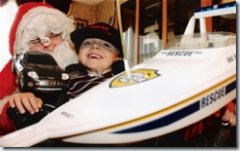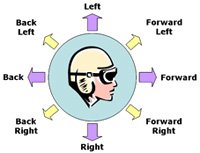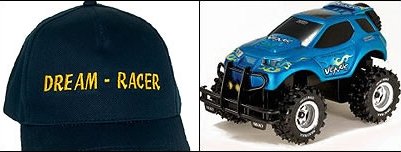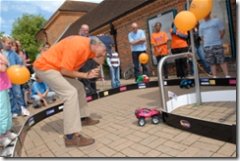|
Dream Racer Provides
|
It has taken close to a year to transform an idea of controlling an RC racer simply by looking left or right and nodding up or down to control the speed.
The Dream Racer was developed almost a year ago by Rehab Robotics' senior design engineer Mark Heath at the firm’s base on the Staffordshire University campus in College Road, Shelton.
| ROBOTICS wizards developed Dream Racer to make a youngster's 2006 Christmas wish come true. Little Daniel Reeves, of Sandyford, was left paralyzed from the neck down when he was hit by a car while on holiday in Greece last year. But the five-year-old's frustration at not being able to play with his toys has now been ended by the Round Table charity and the engineers. |  |
| Daniel Reeves Gets First Robotic RC Toys |
It is called the Dream Racer. It will be a while before it is widely available in the U.S., but it should be in the hands of British Disabled children this fall.
"Presently we have appointed one distributor that covers UK and Ireland but others will follow next year," said Mike Taylor, Excitim Limited and partner in Dream Racer Technology.
You don't have to be disabled to enjoy the concept of "mind over racer". Taylor said anyone can play with a Dream-Racer adapted car or truck. "The product was originally designed for a young boy that could only move his head – he had lost all other body mobility in a road accident."
 The user wears the Dream-Racer hat and drivers' the car by moving their head forward or back, left or right. Each Dream-Racer hat can be fine tuned to the capabilities of the driver and their car can be made to run faster or slower depending on how proficient their driving skills become.
The user wears the Dream-Racer hat and drivers' the car by moving their head forward or back, left or right. Each Dream-Racer hat can be fine tuned to the capabilities of the driver and their car can be made to run faster or slower depending on how proficient their driving skills become.
The same technology can be mounted in a glove or shoe to cater for various levels of disability the driver may have.
"We are working with Nikko produced cars and trucks. We adapt their products by coupling them to a motion sensitive interface. We chose to work with Nikko because they are a well known brand but, we have also worked with products from other companies when asked for something special," said Taylor.

The range of the Dream Racer cap is typically around 25-30 ft radius – relatively short range. This is an important aspect as many of the users have limited mobility to chase after the car or truck.
He added, "whilst we are producing Dream-Racer (and Dream-Gamer and Dream-Mouse) primarily for individuals that suffer some form of physical disability there is absolutely no reason why an able bodied person could not play with Dream-Racer."
But the main emphasis for the project has always been that Dream-Racer enables a disadvantaged person to play alongside an able bodied individual.
 Recently that was put to the test when Damon Hill (Formula 1 world racing champion 1996) tried driving one of the trucks around a simple track using his head.
Recently that was put to the test when Damon Hill (Formula 1 world racing champion 1996) tried driving one of the trucks around a simple track using his head.
This was at an event called Disability Challengers, a fund raiser where Hill took on six would-be challengers.
Reportedly, the champion regained much pride following a convincing win in the fifth race: narrowing the score to 3:2 behind the challengers. The sixth and final circuit was crucial.
Alas, not! The champion was out-driven 4:2 and the Dream-Racer Disability Challengers' championship title went to the six very determined challengers - now champions each.
Dream Racer is now a product of Quality Enabling Devices LtdRiverside Court, Huddersfield Road, Delph. Oldham in the UK.



